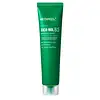What's inside
What's inside
 Key Ingredients
Key Ingredients

 Benefits
Benefits

 Concerns
Concerns

 Ingredients Side-by-side
Ingredients Side-by-side

Water
Skin ConditioningSimmondsia Chinensis Seed Oil
EmollientPolyvinyl Alcohol
Methylpropanediol
SolventButylene Glycol
HumectantCaprylic/Capric Triglyceride
Masking1,2-Hexanediol
Skin ConditioningNiacinamide
SmoothingAlanine
MaskingPolyglyceryl-10 Oleate
Skin ConditioningPolysorbate 80
EmulsifyingPullulan
Centella Asiatica Flower/Leaf/Stem Extract
Skin ConditioningSphingomonas Ferment Extract
Skin ConditioningHydrolyzed Safflower Flower Extract
Skin ConditioningGardenia Taitensis Callus Extract
AntioxidantCentella Asiatica Extract
CleansingAngelica Archangelica Extract
Skin ConditioningTerminalia Ferdinandiana Fruit Extract
AntioxidantPyrus Malus Fruit Extract
Skin ConditioningCarica Papaya Fruit Extract
Skin ConditioningVitis Vinifera Fruit Extract
Skin ConditioningHydrogenated Lecithin
EmulsifyingGlyceryl Stearate
EmollientPEG-100 Stearate
Panthenol
Skin ConditioningDisteardimonium Hectorite
StabilisingSodium Polystyrene Sulfonate
Emulsion StabilisingMicrocrystalline Cellulose
AbsorbentTocopheryl Acetate
AntioxidantEthylhexylglycerin
Skin ConditioningAllantoin
Skin ConditioningAdenosine
Skin ConditioningCellulose Gum
Emulsion StabilisingSodium Phytate
Dextrin
AbsorbentHydrolyzed Wheat Flour
Skin ConditioningTocopherol
AntioxidantCitric Acid
BufferingMadecassoside
AntioxidantGlycerin
HumectantXylitylglucoside
HumectantAnhydroxylitol
HumectantXylitol
HumectantSilica
AbrasiveKaolin
AbrasiveMadecassic Acid
Skin ConditioningAsiaticoside
AntioxidantAsiatic Acid
Skin ConditioningPentylene Glycol
Skin ConditioningPolyglyceryl-10 Stearate
Skin ConditioningSodium Ascorbyl Phosphate
AntioxidantRetinyl Palmitate
Skin ConditioningBiotin
AntiseborrhoeicOligopeptide-3
Skin ConditioningThiamine Hcl
MaskingFolic Acid
Skin ConditioningPyridoxine
Skin ConditioningCyanocobalamin
Skin ConditioningSalicylic Acid
MaskingParfum
MaskingWater, Simmondsia Chinensis Seed Oil, Polyvinyl Alcohol, Methylpropanediol, Butylene Glycol, Caprylic/Capric Triglyceride, 1,2-Hexanediol, Niacinamide, Alanine, Polyglyceryl-10 Oleate, Polysorbate 80, Pullulan, Centella Asiatica Flower/Leaf/Stem Extract, Sphingomonas Ferment Extract, Hydrolyzed Safflower Flower Extract, Gardenia Taitensis Callus Extract, Centella Asiatica Extract, Angelica Archangelica Extract, Terminalia Ferdinandiana Fruit Extract, Pyrus Malus Fruit Extract, Carica Papaya Fruit Extract, Vitis Vinifera Fruit Extract, Hydrogenated Lecithin, Glyceryl Stearate, PEG-100 Stearate, Panthenol, Disteardimonium Hectorite, Sodium Polystyrene Sulfonate, Microcrystalline Cellulose, Tocopheryl Acetate, Ethylhexylglycerin, Allantoin, Adenosine, Cellulose Gum, Sodium Phytate, Dextrin, Hydrolyzed Wheat Flour, Tocopherol, Citric Acid, Madecassoside, Glycerin, Xylitylglucoside, Anhydroxylitol, Xylitol, Silica, Kaolin, Madecassic Acid, Asiaticoside, Asiatic Acid, Pentylene Glycol, Polyglyceryl-10 Stearate, Sodium Ascorbyl Phosphate, Retinyl Palmitate, Biotin, Oligopeptide-3, Thiamine Hcl, Folic Acid, Pyridoxine, Cyanocobalamin, Salicylic Acid, Parfum
Water
Skin ConditioningGlycerin
HumectantKaolin
AbrasiveCaprylic/Capric Triglyceride
Masking1,2-Hexanediol
Skin ConditioningPhaseolus Angularis Seed Powder
Hectorite
AbsorbentCetyl Alcohol
EmollientGlyceryl Stearate Se
EmulsifyingCetearyl Olivate
Sorbitan Olivate
EmulsifyingPhaseolus Angularis Seed Extract
AntioxidantUltramarines
Pyrus Communis Fruit Extract
Skin ConditioningEthylhexylglycerin
Skin ConditioningSodium Acrylate/Sodium Acryloyldimethyl Taurate Copolymer
Emulsion StabilisingHedera Helix Leaf/Stem Extract
AntimicrobialPolyisobutene
Fragaria Chiloensis Fruit Extract
Skin ConditioningPyrus Malus Leaf Extract
Skin ConditioningCI 77491
Cosmetic ColorantCaprylyl/Capryl Glucoside
CleansingSorbitan Oleate
EmulsifyingTriethoxycaprylylsilane
Water, Glycerin, Kaolin, Caprylic/Capric Triglyceride, 1,2-Hexanediol, Phaseolus Angularis Seed Powder, Hectorite, Cetyl Alcohol, Glyceryl Stearate Se, Cetearyl Olivate, Sorbitan Olivate, Phaseolus Angularis Seed Extract, Ultramarines, Pyrus Communis Fruit Extract, Ethylhexylglycerin, Sodium Acrylate/Sodium Acryloyldimethyl Taurate Copolymer, Hedera Helix Leaf/Stem Extract, Polyisobutene, Fragaria Chiloensis Fruit Extract, Pyrus Malus Leaf Extract, CI 77491, Caprylyl/Capryl Glucoside, Sorbitan Oleate, Triethoxycaprylylsilane
 Reviews
Reviews

Ingredients Explained
These ingredients are found in both products.
Ingredients higher up in an ingredient list are typically present in a larger amount.
1,2-Hexanediol is a synthetic liquid and another multi-functional powerhouse.
It is a:
- Humectant, drawing moisture into the skin
- Emollient, helping to soften skin
- Solvent, dispersing and stabilizing formulas
- Preservative booster, enhancing the antimicrobial activity of other preservatives
This ingredient is an emollient, solvent, and texture enhancer. It is considered a skin-softener by helping the skin prevent moisture loss.
It helps thicken a product's formula and makes it easier to spread by dissolving clumping compounds.
Caprylic Triglyceride is made by combining glycerin with coconut oil, forming a clear liquid.
While there is an assumption Caprylic Triglyceride can clog pores due to it being derived from coconut oil, there is no research supporting this.
Learn more about Caprylic/Capric TriglycerideEthylhexylglycerin (we can't pronounce this either) is commonly used as a preservative and skin softener. It is derived from glyceryl.
You might see Ethylhexylglycerin often paired with other preservatives such as phenoxyethanol. Ethylhexylglycerin has been found to increase the effectiveness of these other preservatives.
Glycerin is already naturally found in your skin. It helps moisturize and protect your skin.
A study from 2016 found glycerin to be more effective as a humectant than AHAs and hyaluronic acid.
As a humectant, it helps the skin stay hydrated by pulling moisture to your skin. The low molecular weight of glycerin allows it to pull moisture into the deeper layers of your skin.
Hydrated skin improves your skin barrier; Your skin barrier helps protect against irritants and bacteria.
Glycerin has also been found to have antimicrobial and antiviral properties. Due to these properties, glycerin is often used in wound and burn treatments.
In cosmetics, glycerin is usually derived from plants such as soybean or palm. However, it can also be sourced from animals, such as tallow or animal fat.
This ingredient is organic, colorless, odorless, and non-toxic.
Glycerin is the name for this ingredient in American English. British English uses Glycerol/Glycerine.
Learn more about GlycerinKaolin is a clay. It is used for oil control and to help minimize pores. Like other clays, kaolin has the ability to absorb excess sebum or oil. This can help clean out pores and mattify the skin.
Some types of kaolin may have exfoliating properties. When water is added to kaolin, it becomes a paste with small abrasive particles.
Most kaolin is a white color, but may be pink/orange/red depending on where it comes from.
The name 'kaolin' comes from a Chinese village named 'Gaoling'. Kaolin clay comes from rocks rich in kaolinite. Kaolinite, the mineral, has a silicate layered structure. Kaolinite is formed from chemical weathering of aluminum siilicate minerals.
Besides skincare, kaolin is commonly used to make glossy paper, in ceramics, toothpaste, and as medicine to soothe stomach issues.
Learn more about KaolinWater. It's the most common cosmetic ingredient of all. You'll usually see it at the top of ingredient lists, meaning that it makes up the largest part of the product.
So why is it so popular? Water most often acts as a solvent - this means that it helps dissolve other ingredients into the formulation.
You'll also recognize water as that liquid we all need to stay alive. If you see this, drink a glass of water. Stay hydrated!
Learn more about Water